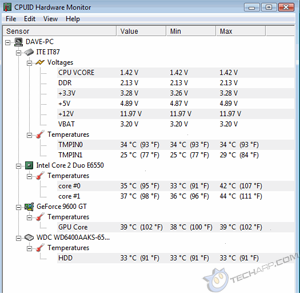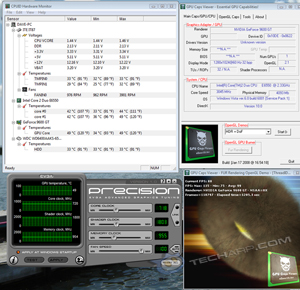Testing The NZXT Tempest Case
The Testbed
Processor |
Intel Core 2 Duo E6550 Processor |
|
Cooler |
Cooler Master Hyper212 |
|
Motherboard |
Gigabyte GX-X38-DQ6 |
|
Memory Modules |
OCZ ReaperX PC2-8500 DDR2 memory |
|
Graphics Card |
Gainward Bliss 9600 GT 512MB DDR3 |
|
Hard Drive |
Western Digital 640 GB Caviar SE16 hard drive |
Idle Temperatures
We tested the Tempest along with the Coolermaster RC-690 case at idle with the same system components installed in both. The Coolermaster case sells for about US$ 80 while the Tempest goes for around US$ 100.
 |
|
NZXT Tempest Idle Temperatures |
Cooler Master RC-690 Idle Temperatures |
The airflow in both cases were similar in concept. However, the CPU, GPU and hard drive temperatures were all much lower in the Tempest than they were in the Cooler Master case.
Tempest Airflow & Temperatures
We used a program called GPU Caps using the “FUR” test with a high setting of MSAA=8X. We ran the following parameters in order for about 20 minutes.
- Tested the case air flow with the GeForce 9600 GT fan manually to 100%.
- Tested the case and side fan air flow with the GeForce 9600 GT fan set Auto (default 35%).
To generate more heat, we overclocked the GeForce 9600 GT from its standard clock speeds of 650 MHz core and 900 MHz memory to 720 MHz core and 950 MHz memory.
 |
|
Test 1 Results |
Test 2 Results |
The side panel's fan really helped reduce the temperature of the graphics card. In our test, enabling the side panel fan reduced the GPU core temperature from 60 °C to about 49 °C. That's a reduction in temperature of 11 °C or about 18.3 %.
Support Tech ARP!
If you like our work, you can help support out work by visiting our sponsors, participate in the Tech ARP Forums, or even donate to our fund. Any help you can render is greatly appreciated!







 Add to Reddit
Add to Reddit


